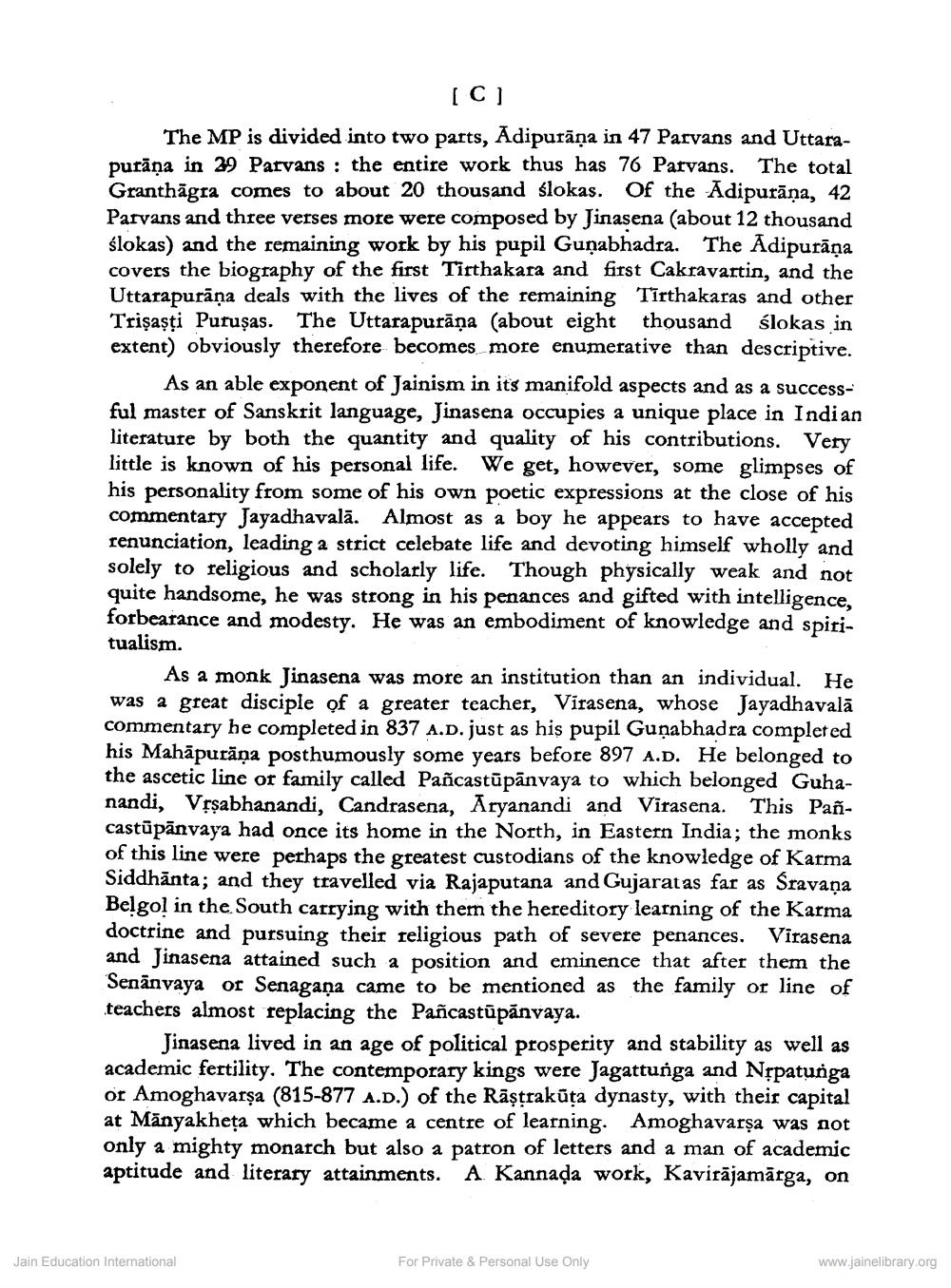Book Title: Uttara Purana Author(s): Gunbhadrasuri, Pannalal Jain Publisher: Bharatiya Gyanpith View full book textPage 9
________________ [C] The MP is divided into two parts, Adipurāņa in 47 Parvans and Uttarapuraṇa in 29 Parvans: the entire work thus has 76 Parvans. The total Granthägra comes to about 20 thousand slokas. Of the Adipurāṇa, 42 Parvans and three verses more were composed by Jinasena (about 12 thousand slokas) and the remaining work by his pupil Gunabhadra. The Adipuraṇa covers the biography of the first Tirthakara and first Cakravartin, and the Uttarapurāṇa deals with the lives of the remaining Tirthakaras and other Trişaşti Purusas. The Uttarapurāņa (about eight thousand ślokas in extent) obviously therefore becomes more enumerative than descriptive. As an able exponent of Jainism in its manifold aspects and as a successful master of Sanskrit language, Jinasena occupies a unique place in Indian literature by both the quantity and quality of his contributions. Very little is known of his personal life. We get, however, some glimpses of his personality from some of his own poetic expressions at the close of his commentary Jayadhavalā. Almost as a boy he appears to have accepted renunciation, leading a strict celebate life and devoting himself wholly and solely to religious and scholarly life. Though physically weak and not quite handsome, he was strong in his penances and gifted with intelligence, forbearance and modesty. He was an embodiment of knowledge and spiri tualism. As a monk Jinasena was more an institution than an individual. He was a great disciple of a greater teacher, Virasena, whose Jayadhavala commentary he completed in 837 A.D. just as his pupil Gunabhadra completed his Mahāpurāṇa posthumously some years before 897 A.D. He belonged to the ascetic line or family called Pañcastūpanvaya to which belonged Guhanandi, Vṛṣabhanandi, Candrasena, Aryanandi and Virasena. This Pañcastūpānvaya had once its home in the North, in Eastern India; the monks of this line were perhaps the greatest custodians of the knowledge of Karma Siddhanta; and they travelled via Rajaputana and Gujaratas far as Sravana Belgol in the South carrying with them the hereditory learning of the Karma doctrine and pursuing their religious path of severe penances. Virasena and Jinasena attained such a position and eminence that after them the Senänvaya or Senagana came to be mentioned as the family or line of teachers almost replacing the Pañcastūpanvaya. Jinasena lived in an age of political prosperity and stability as well as academic fertility. The contemporary kings were Jagattunga and Nṛpatunga or Amoghavarsa (815-877 A.D.) of the Raṣṭrakūta dynasty, with their capital at Manyakheta which became a centre of learning. Amoghavarṣa was not only a mighty monarch but also a patron of letters and a man of academic aptitude and literary attainments. A Kannada work, Kavirajamārga, on Jain Education International For Private & Personal Use Only www.jainelibrary.orgPage Navigation
1 ... 7 8 9 10 11 12 13 14 15 16 17 18 19 20 21 22 23 24 25 26 27 28 29 30 31 32 33 34 35 36 37 38 39 40 41 42 43 44 45 46 47 48 49 50 51 52 53 54 55 56 57 58 59 60 61 62 63 64 65 66 67 68 69 70 71 72 73 74 75 76 77 78 79 80 81 82 83 84 85 86 87 88 89 90 91 92 ... 738
